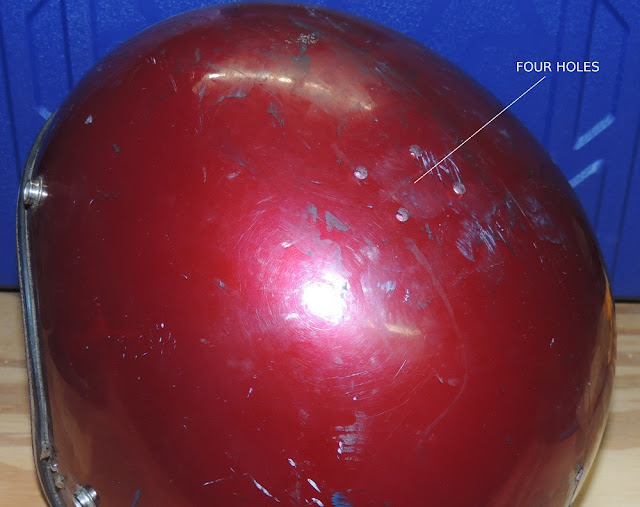Time to catch up on posts. First, some reflection on the helmet I'm refurbishing.
The holes in the helmet being reconstructed do not match the one that was on display at the
Laser Tag Museum, nor do they line up with my recollection. On the helmet for refurbishment there are two cheek holes; the next LEDs (one on each side) are only a few inches back; and there are no holes on the sides, front, or back for hit detectors.
 |
| Side has two LEDs and a light bulb, but—alas, poor Yorick!—no hit sensors. |
Compare this to the helmet previously on display at the Museum in 2015, where each cheek has only one LED; the next LEDs have been moved up where they will be better visible from above; and sensors have been added which can be hit from the sides or from above. Since shoulder-top sensors and lights had not been invented in those days, these would be a must for multi-level arenas.
 |
| Much easier to see or hit this player. |
Returning to the reconstruction helmet, there is also a parietal cluster of four holes on the left side which could have had sensors; but if so, why only on one side, and all in one place? There is nothing like this on the other sample.
 |
| Suspiciously located over a rounded pocket that just happens to fit a small speaker. |
The speaker was missing when the helmet arrived for reconstruction, but this is the most likely place for it, and perhaps it was meant to be heard from outside the helmet as a result of these holes.
 |
| The interior is now fitted with a vintage speaker. |
I've tentatively concluded that this helmet was never fitted with hit
sensors at all, which may explain why its cable and connector had only 4
wires (2 for LEDs, 2 for speaker) on a stubby cable with an Amp CPC connector which is not used anywhere else in the system.
I built the correct cable in the original style, long enough to reach the connector on the pack, which uses an Amp 3470 series Mil-spec connector ... unquestionably the single best design decision made on this pack design.
 |
| Oddball connector on the left. Correct, military grade connector on the right (granted, with strain relief suitable for display only). |
Perhaps this helmet was a
prototype or test fixture not used in the game. Or maybe (since it is a
youth size helmet) it was offered to allow younger, inexperienced players a handicap to improve their scores. Who knows?
It remains to be seen whether the refurbished unit will have the audio circuits working, but we are at least prepared if that turns out to be possible.
Edit: Improved discussion of helmet connector.











